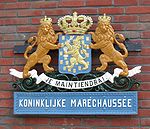| Royal Military Constabulary[1] Koninklijke Marechaussee | |
|---|---|
| Abbreviation | KMar |
 Coat of Arms of the Royal Netherlands Marechaussee | |
| Motto |
Zonder vrees en zonder blaam Without fear and without dishonour |
| Agency overview | |
| Formed | November 26, 1814 |
| Employees | 6000 |
| Legal personality | Governmental: Government agency |
| Jurisdictional structure | |
| National agency (Operations jurisdiction) | Netherlands |
| Legal jurisdiction | As per operations jurisdiction. |
| Governing body | Ministry of Defence (Netherlands) |
| Constituting instrument | Royal Decree of 1954 |
| General nature |
|
| Specialist jurisdictions |
|
| Operational structure | |
| Headquarters | The Hague |
| Agency executive | Luitenant-Generaal Hans Leijtens, Commandant |
| Website | |
| www.marechaussee.nl/ | |
The Koninklijke Marechaussee, the Royal Netherlands Marechaussee, abbreviated to KMar, (English is Royal Marshals, but commonly seen as Royal Military Constabulary) is one of the four Services of the armed forces of the Netherlands. It is a gendarmerie force performing military police and civil police duties.
History
The Corps de Maréchaussée was created by King William I to replace the French Gendarmerie on October 26, 1814. The word gendarmerie had gained a negative connotation, so William called the new force "marechaussée" (he forgot the first acute accent in the document). Maréchaussée is an alternate French word for gendarmerie. At that time, the Marechaussee was a part of the army (landmacht). The Marechaussee was tasked with maintaining public order, law enforcement, and safeguarding the main roads. Although not specifically mentioned, this included police duties for the army. As such, the Marechaussee was part of the national police (rijkspolitie).

A Marechaussee van
The Marechaussee was the only police force in many small municipalities, such as Venlo, especially in the southern provinces of Limburg and North Brabant.
In 1908, Queen Wilhelmina assigned the Marechaussee the task of guarding the royal palaces, which had previously been done by gardeners. To this day, guarding a palace is called "klompendienst" (clog service).
On July 5, 1940, the German occupation government merged the Marechaussee with the rijksveldwacht and the gemeenteveldwacht. This meant that the Marechaussee lost its military status and the predicate Royal. These changes did not apply to the Marechaussee outside occupied Dutch territory. About 200 marechaussees guarded the Royal Family and the Dutch government-in-exile, and provided military police services to the Princess Irene Brigade, a brigade formed in the United Kingdom, consisting of Dutchmen.
After World War II, the Marechaussee was split into a Korps Rijkspolitie (National Police Corps) (as a replacement of the rijksveldwacht and the gemeenteveldwacht) and the Royal Marechaussee, which regained its military status. The main tasks for the Marechaussee since then have been border protection, military police and guard duties.
On July 3, 1956, Princess Beatrix became patroness of the Royal Netherlands Marechaussee.
In 1994, the national and municipal police forces were merged into the present 25 regional police forces and the Korps landelijke politiediensten (National Police Services Agency). The National Police transferred its airport police and security tasks (primarily Schiphol) to the Marechaussee.
In 1998, the Marechaussee became a separate Service within the armed forces.
Emblem

The Grenade
The emblem of the Royal Netherlands Marechaussee is, as with many other gendarmerie forces, a flaming grenade. In the 17th century, a new weapon was introduced in Europe: the hand grenade. The soldiers who handled grenades were called grenadiers. They became an elite type of soldier in all European armies. In France, the grenade symbol was adopted by the gendarmerie, and this was imitated by similar forces throughout Europe.
The flaming grenade (but in this case within an eight-pointed star) was also the emblem of the Rijkspolitie.
Present KMar
The present marechaussee is a police organisation with a military status, under the jurisdiction of the Ministry of Defense, but mostly working for the Ministry of Justice and the Ministry of the Interior and Kingdom Relations. The RNLM performs the following duties:
- assistance to and replacement of the police
- escorting and protection of NATO convoys
- fighting illegal immigration
- fighting international crime
- guarding the national borders
- guarding the royal palaces and the house of the Prime Minister
- military police functions for the Dutch Armed Forces
- riot control and protection
- security and police work at all civilian airports, notably Schiphol Airport
- VIP close protection including the Royal Family and high-ranking government officials
- Special Protection Assignments Brigade (BSB), special forces for arrests, surveillance and protection
- KMOO, the Military Police Service
The first four units are territorial, other two have national rather than regional responsibilities.
Ranks
This link shows the actual ranks in the Royal Netherlands Navy, Army, Air Force and Marechaussee (Military Police): Military ranks of the Dutch armed forces
Equipment
- Diemaco C7
- Diemaco C8
- Glock 17
- Glock 26
- Heckler & Koch HK416
- Heckler & Koch MP5
- FN 303
- FN MAG (only on AIFV armoured vehicles)
Spelling
In the course of time the two acute accents of the French spelling (Maréchaussée) were dropped. The lowest ranking personnel are referred to as marechaussees (without the capital M), a rank comparable to lance corporal & corporals.
See also
| Wikimedia Commons has media related to Koninklijke Marechaussee. |
- Dutch police
- Gendarmerie
References
External links
- Marechaussee information on the Defence Ministry website (in English)
- Official Marechaussee website (in Dutch)
| |||||||||||
The original article can be found at Royal Marechaussee and the edit history here.